More detailed information will be added to this page
Marcus Anthonius (143 BC-87 BC)
|
Marcus Anthonius Crecitus (103 BC-71 BC) M. Julia Caesia Caesonia Caesar (103 BC-?) (Grandmother of Julius Ceasar)
|
Marcus Anthonius Triumvir of Rome (83 BC-30 BC)
1st wife: Octavia Thurina Minor Octavius (69 BC-11 BC) (see E. above)
2nd wife: Cleopatra VII of Egypt (69 BC -30 BC)
|
Anthonia Augusta Anthonia (35 BC-37) (from 1st wife above)
|
Claudius Tiberius Caesar Augustus Germanicus (Claudius I) Keizer van het Romeinse Rijk (10 BC-54) (Roman Emperor during the time of Jesus)
|
Geniussa Julia Claudia Princess of Rome
|
Meric Ap-Gweyridd King of Bretagne (?-76 AD)
|
Coel II Ap-Meric King of Bretagne (60-142). Watch video
|
Althide of Bretagne (85-?)
|
Clodomir IV of Sicambrie Lord of Franks (103-166)
|
Farabert of Sicambrie Lord of Franks (122-186)
|
Sunno of Sicambrie Lord of Franks (150-213)
|
Childeric I of Sicambrie Lord of Franks (175-253)
|
Batherus of Sicambrie Lord of Franks (200-272)
|
Chlodomir V of Sicambrie Lord of Franks (225-295)
|
Waldradus of Sicambrie Lord of Franks (250-306)
|
Dagobert I King of Sicambrie Lord of Franks (275-317)
|
Genebald I King of Sicambrie Lord of Franks (300-368)
|
Dagobert II of Cologne of Sicambrie Lord of Franks (320-379)
|
Clodius of Cologne of Sicambrie Lord of Franks (345-398)
|
Marcomir of Cologne King of Franks (365-400)
|
Ildegonde of Cologne (395-450) ~ Chlodion the Riparian of Cologne
She was the daughter of Marcomir of Cologne, King of the Franks and his wife Ildegonde di Lombardia.
She married Walter de Vasconie and had a son: Cimon d'Aquitaine.
In 417 she married Chlodion Lord of the Franks King of Thérouanne and Cambrai (392-448).
|
Chlodoswintha of Cologne (418-449) ~435~ Merovech King of the Salian Franks (415-458)

A certain ancient legend holds that Merovech was conceived under parnormal or divine circumstances. It is said that Pharamond's wife, while swimming, encountered a Quinotauror sea monster, which presumably could change shapes. Though never stated, it is implied that she was impregnated by it. This legend was related by Fredegar in the seventh century and may have been known earlier. The legend is probably a back-formation or folk etymology used to explain the Salian Franks' origin as a coastal culture, and was thus based on the name itself. The "Mero-" or "Mer-" element in the name suggests a sea or ocean (see Old English "mere," Latin "mare," or even the Modern English word "mermaid", etc.). The "Salian" in "Salian Franks" may be a reference to salt, a reminder of their pre-migration home on the shores of the North Sea.
The legend could also be explained in a much easier way. The sea monster could have been a foreign conqueror, coming from the sea, taking the dead king's (Chlodio or Pharamond) wife to legitimise his rule. Another explanation holds that the sea monster which could change shape is metaphoric prose for the Roman governmental System, and perhaps its controlling families, still present in the area. Eventually the Merovingians, and their Frankish legacy, would indeed continue the legal and cultural tradition of the Roman Empire throughout Central and Northern Europe (and thus the world) in direct and indirect ways.
Reference in popular culture:
The legend about Merovech's conception was adapted in 1982 by authors Henry Lincoln and Richard Leigh in their book Holy Blood Holy Grail, as the seed of a new idea. They hypothesized that this "descended from a fish" legend was actually referring to the concept that the Merovingian line had married into the bloodline of Jesus Christ and Mary Magdalene, since the symbol for early Christians had also been a fish. This theory, was further popularized in 2003 via Dan Brown's bestselling novel, The Da Vinci Code.
|
Childeric I King of the Franks (440-481) ~
In 463 Childeric fought in conjunction with the Roman General Aegidius, the magister militum of northern Gaul based in Soissons, to defeat the Visigoths, who had hoped to extend their dominion along the banks of the Loire River. After the death of Aegidius, Childeric assisted Comes ("count") Paul of Angers, together with a mixed band of Gallo-Romans and Franks, in defeating the Goths and taking booty.
Childeric's tomb was discovered on 27 May 1653 by a mason doing repairs in the church of Saint-Brice in Tournai, Belgium. Numerous precious objects were found, including a richly ornamented sword, a torse-like bracelet, jewels of gold and garnet cloisonn , gold coins, a gold bull's head, and a ring (see below) with the inscription CHILDERICI REGIS ("of Childeric the king"), which identified the tomb. Some 300 golden bees, cloisonnéed with garnets (see examples below) were also found.
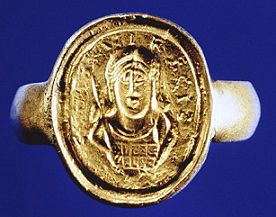
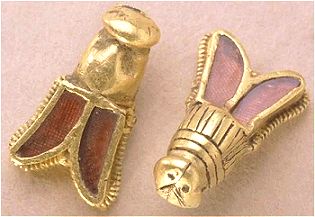 Basina of Thuringia Queen of Thuringia (438-477)
Basina of Thuringia Queen of Thuringia (438-477)
She left her husband, king Bisinus and went to Roman Gaul. She herself took the initiative to ask for the hand of Childeric I, king of the Franks, and married him. For as she herself said, "I want to have the most powerful man in the world, even if I have to cross the ocean for him". This remark of hers may have been related to Childeric's successful invasion of the Roman Empire and his attempt to settle a Frankish kingdom on Roman soil.
Basina's name is probably Low Franconian for 'female boss'. She is the mother of the man who is remembered as the founder of the Frankish realm and modern France. She (not her husband Childeric) named her son Chlodovech, but he is better remembered under his Latinized name, Clovis I. The simple fact that Chlodovech's name comes from Basina is remarkable since it was a common practice for the Franks to name a son after a member of the family of the male-line of ancestors.
Through the ages historians have been intrigued by the story of Basina since she obviously acted as a player and not as bystander which is not uncommon for women of the German clans, but highly uncommon for the Romans.
|
Clovis I King of the Franks (466-511) ~493~
Clovis was the son of Childeric I, a Merovingian king of the Salian Franks, and Basina, Queen of Thuringia. He succeeded his father in 481, at the age of fifteen. He is considered the founder of the Merovingian dynasty, which ruled the Franks for the next two centuries.
Clovis converted to Catholicism at the instigation of his wife, Clotilde, a Burgundian princess who was a Catholic in spite of the Arianism that surrounded her at court. He was baptized on Christmas Day, 496, in a small church in the vicinity of the subsequent Abbey of Saint-Remi in Reims; a statue of him being baptized by Saint Remigius can still be seen there. Clovis and his wife were first buried in the Abbey of St Genevieve (St. Pierre) in Paris, but later moved to the Basilica of St Denis (also in Paris).
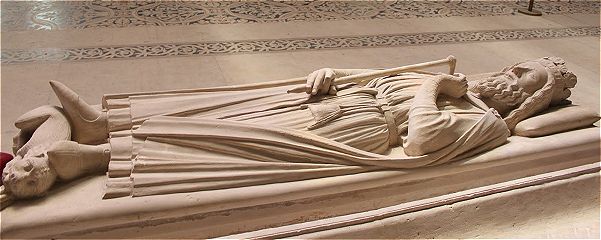
Tomb of Clovis in the Basilica of St Denis in Paris
Saint Clotilde of Burgundy (475-545)

|
Childebert I Meroving King of Franks (495-558) ~522~ Ultrogothe Balthes Princess of Ostrogoths
King of Orleans (526) and King of Burgundy (534).
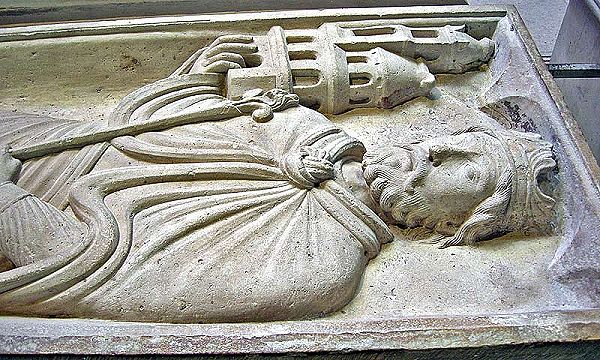
Tomb of Childebert with a small Basilica of St Denis in his hand
|
Garibald I Meroving Duke of Bavaria (530-590) ~556~ Waldrade Princess of Lombardy (532-567)
|
Gertrude (of the Bavarians) Meroving (556-645) ~585~ Carloman of Landen (545-615)
|
St. Pepin of Landen (585-640) ~
Pepin's father is named Carloman by the Chronicle of Fredegar, the chief source for his life. His byname comes from his probable birthplace: Landen, modern Belgium. He is sometimes called Pepin I and his other nicknames (Elder and Old) come from his position at the head of the family called the Pippinids after him. Through the marriage of his daughter Begga to Ansegisel, a son of Arnulf of Metz, the clans of the Pippinids and the Arnulfings were united, giving rise to a family which would eventually rule the Franks as the Carolingians.
Pepin was praised by his contemporaries for his good government and wise counsel. Though some enemies tried to turn the king against him, their plots were foiled and Pepin remained on good terms with the king until 629, when, for reasons unknown, he retired (or was retired) to his estates, where he remained for the next decade, until Dagobert's death.
On his death, Pepin came out of retirement to take on the mayoralty in Austrasia for the heir Sigebert III and to oversee the distribution of the treasury between Sigebert and his brother, Clovis II, and his stepmother Nanthild, who was ruling on Clovis' behalf in Neustria and Burgundy. Sigebert's share of the inheritance was amicably surrendered, partly because of the friendship between Pepin and the Burgundian mayor of the palace, Aega. Pepin and Arnulf's successor as chief counselor to the king, Cunibert, Bishop of Cologne, received the treasure at Compi gne and brought it back to Metz.
 Not long after, both Pepin and Aega died. He was so popular in Austrasia that, though he was never canonized, he was listed as a saint in some martyrologies. His feast day was 21 February.
Saint Itta of Nivelles (592 642)
Not long after, both Pepin and Aega died. He was so popular in Austrasia that, though he was never canonized, he was listed as a saint in some martyrologies. His feast day was 21 February.
Saint Itta of Nivelles (592 642)

Itta had another daughter, Abbess Begga of Andenne who married Ansegisel, son of Arnulf of Metz. By Begga, she is the grandmother of Pepin of Herstal and one of the matriarchs of the great Carolingian family. Her sons were Grimoald, later mayor of the palace, and father of King Childebert the Adopted.
Her second son Bavo (or Allowin), became a hermit and was later canonized. Both her daughters were later canonised, as was she. Her feast day is May 8 (day she died).
|
Holy Begga of Landan (610-693) ~ Ansegilius of Metz Lord of Franks (610-662)

The rich monastery of Andenne was afterwards converted into a collegiate church of thirty-two canonesses of noble families, with ten canons to officiate at the altar.
|
Pepin II of Herstal (650-714) ~ Alpaida
The son of the powerful Frankish statesman, Ansegisel, Pepin worked to establish his family, the Pippinids, as the strongest in Francia. He was able to realise his dreams by becoming Mayor of the Palace in Austrasia in 680. Pepin subsequently embarked on several wars to expand his power. He united all the Frankish realms by the conquest of Neustria and Burgundy in 687. In foreign conflicts, Pepin increased the power of the Franks by his subjugation of the Alemanni, the Frisians, and the Franconians. He also began the process of evangelisation of Germany.

Pepin's statesmanship was notable for the further diminution of Merovingian royal authority, and for the acceptance of the undisputed right to rule for his family. Therefore, Pepin was able to name as heir, his grandson, Theudoald. But, this was not accepted by his powerful bastard son, Charles Martel, leading to a civil war after his death in which the latter emerged victorious.
|
Charles Martel (688-741) ~married in 709~ Rotrudis (Chrotrud) of Trier (690-724)
The illegitimate son of Frankish strongman, Pepin of Heristal, and a noblewoman named Alpaida, Martel successfully asserted his claims to power as successor to his father as the power behind the throne in Frankish politics. Continuing and building on his father's work, he restored centralized government in Francia and began the series of military campaigns that re established the Franks as the undisputed masters of all Gaul. In foreign wars, Martel subjugated Bavaria, Alemannia, Frisia, vanquished the pagan Saxons, and halted the Islamic advance into Western Europe at the Battle of Tours.
Martel is considered to be the founding figure of the European Middle Ages. Skilled as an administrator and warrior, he is often credited with a seminal role in the development of feudalism and knighthood. Martel was a great patron of Saint Boniface and made the first attempt at reconciliation between the Papacy and the Franks. The Pope wished him to become the defender of the Holy See and offered him the Roman consulship. Martel refused the offer, but it was a sign of the things to come.
Although Martel never assumed the title of king, he divided Francia, like a king, between his sons Carloman and Pepin. The latter became the first of the Carolingians, the family of Charles Martel, to become king. Martel's grandson, Charlemagne, extended the Frankish realms to include much of the West, and became the first Emperor since the fall of Rome. Therefore, on the basis of his achievements, Martel is seen as laying the groundwork for the Carolingian Empire.
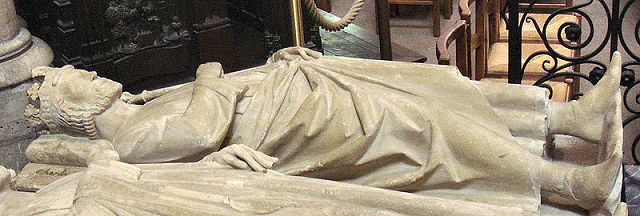
Tomb of Charles Martel in the Basilica of St Denis in Paris
|
Pepin III (King of Franks) (715-768) ~married in 743~ Betrada II of Laon (720-783)
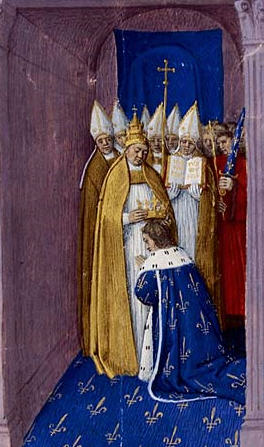 Pepin, commonly known as Pepin the Short or Pepin the Great, was the King of the Franks from 752 until his death. He was the first of the Carolingians to become not only de facto but also de jure ruler of Francia.
Pepin, commonly known as Pepin the Short or Pepin the Great, was the King of the Franks from 752 until his death. He was the first of the Carolingians to become not only de facto but also de jure ruler of Francia.
The younger son of Frankish strongman, Charles Martel, Pepin's upbringing was distinguished by the ecclesiastical education he had received from the monks of St. Denis. Succeeding his father as the Mayor of the Palace in 741, Pepin reigned over Francia jointly with his elder brother Carloman. Pepin ruled in Neustria, Burgundy, and Provence, while his brother Carloman established himself in Austrasia, Alemannia and Thuringia. The brothers were active in subjugating revolts led by the Bavarians, Aquitanians, Saxons, and the Alemanni in the early years of their reign. In 743, they ended the Frankish interregnum by choosing Childeric III, who was to be the last Merovingian monarch, as figurehead king of the Franks.
Being well disposed towards the church and Papacy on account of their ecclesiastical upbringing, Pepin and Carloman continued their father's work in supporting Saint Boniface in reforming the Frankish church, and evangelising the Saxons. After Carloman, who was an intensely pious man, retired to religious life in 747, Pepin, became the sole ruler of the Franks.
This 15th century illumination on vellum shows the coronation of Pepin by Boniface, Archbishop of Mainz, in 752.
Pepin died during a campaign, in 768 at the age of 54. He was interred in the church of Saint Denis. His wife Bertrada was also interred there in 783. Their son Charlemagne rebuilt the Basilica in honor of his parents and placed markers at the entrance.
|
Click arrow to continue down the Van O. family tree

Marcus Anthonius (143 BC-87 BC)
|
Marcus Anthonius Crecitus (103 BC-71 BC) M. Julia Caesia Caesonia Caesar (103 BC-?) (Grandmother of Julius Ceasar)
|
Marcus Anthonius Triumvir of Rome (83 BC-30 BC)
1st wife: Octavia Thurina Minor Octavius (69 BC-11 BC) (see E. above)
2nd wife: Cleopatra VII of Egypt (69 BC -30 BC)
|
Anthonia Augusta Anthonia (35 BC-37) (from 1st wife above)
|
Claudius Tiberius Caesar Augustus Germanicus (Claudius I) Keizer van het Romeinse Rijk (10 BC-54) (Roman Emperor during the time of Jesus)
|
Geniussa Julia Claudia Princess of Rome
|
Meric Ap-Gweyridd King of Bretagne (?-76 AD)
|
Coel II Ap-Meric King of Bretagne (60-142). Watch video
|
Althide of Bretagne (85-?)
|
Clodomir IV of Sicambrie Lord of Franks (103-166)
|
Farabert of Sicambrie Lord of Franks (122-186)
|
Sunno of Sicambrie Lord of Franks (150-213)
|
Childeric I of Sicambrie Lord of Franks (175-253)
|
Batherus of Sicambrie Lord of Franks (200-272)
|
Chlodomir V of Sicambrie Lord of Franks (225-295)
|
Waldradus of Sicambrie Lord of Franks (250-306)
|
Dagobert I King of Sicambrie Lord of Franks (275-317)
|
Genebald I King of Sicambrie Lord of Franks (300-368)
|
Dagobert II of Cologne of Sicambrie Lord of Franks (320-379)
|
Clodius of Cologne of Sicambrie Lord of Franks (345-398)
|
Marcomir of Cologne King of Franks (365-400)
|
Ildegonde of Cologne (395-450) ~ Chlodion the Riparian of Cologne
Ildegonde de Cologne (395-450)
Ildegonde (Hillegonde) was born in Cologne, Germany.She was the daughter of Marcomir of Cologne, King of the Franks and his wife Ildegonde di Lombardia.
She married Walter de Vasconie and had a son: Cimon d'Aquitaine.
In 417 she married Chlodion Lord of the Franks King of Thérouanne and Cambrai (392-448).
|
Chlodoswintha of Cologne (418-449) ~435~ Merovech King of the Salian Franks (415-458)
Merovech King of the Salian Franks (415-458)

Silvered bronze mount of an armoire depicting the victory of Merovingian King Merovech over the armies of Attila the Hun in 451. By Emmanuel Fremiet, 1867. In the collection of the Metropolitan Museum of Art, NY.
Merovech (Latin: Meroveus or Merovius) is the semi-legendary founder of the Merovingian dynasty of the Salian Franks, which later became the dominant Frankish tribe. He is said to be one of several barbarian warlords and kings that joined forces with the Roman general Aetius against the Huns under Attila on the Catalaunian fields in Gaul. The first Frankish royal dynasty called themselves Merovingians ("descendants of Meroveus") after him.
A certain ancient legend holds that Merovech was conceived under parnormal or divine circumstances. It is said that Pharamond's wife, while swimming, encountered a Quinotauror sea monster, which presumably could change shapes. Though never stated, it is implied that she was impregnated by it. This legend was related by Fredegar in the seventh century and may have been known earlier. The legend is probably a back-formation or folk etymology used to explain the Salian Franks' origin as a coastal culture, and was thus based on the name itself. The "Mero-" or "Mer-" element in the name suggests a sea or ocean (see Old English "mere," Latin "mare," or even the Modern English word "mermaid", etc.). The "Salian" in "Salian Franks" may be a reference to salt, a reminder of their pre-migration home on the shores of the North Sea.
The legend could also be explained in a much easier way. The sea monster could have been a foreign conqueror, coming from the sea, taking the dead king's (Chlodio or Pharamond) wife to legitimise his rule. Another explanation holds that the sea monster which could change shape is metaphoric prose for the Roman governmental System, and perhaps its controlling families, still present in the area. Eventually the Merovingians, and their Frankish legacy, would indeed continue the legal and cultural tradition of the Roman Empire throughout Central and Northern Europe (and thus the world) in direct and indirect ways.
Reference in popular culture:
The legend about Merovech's conception was adapted in 1982 by authors Henry Lincoln and Richard Leigh in their book Holy Blood Holy Grail, as the seed of a new idea. They hypothesized that this "descended from a fish" legend was actually referring to the concept that the Merovingian line had married into the bloodline of Jesus Christ and Mary Magdalene, since the symbol for early Christians had also been a fish. This theory, was further popularized in 2003 via Dan Brown's bestselling novel, The Da Vinci Code.
|
Childeric I King of the Franks (440-481) ~
Childeric (440-481) was a Merovingian king of the Salian Franks
Childeric succeeded his father Merovech as king of the Salian Franks, in 458. With his Frankish warband he established his capital at Tournai, on lands he had received as a foederatus of the Romans, and for some time he kept the peace with his allies.In 463 Childeric fought in conjunction with the Roman General Aegidius, the magister militum of northern Gaul based in Soissons, to defeat the Visigoths, who had hoped to extend their dominion along the banks of the Loire River. After the death of Aegidius, Childeric assisted Comes ("count") Paul of Angers, together with a mixed band of Gallo-Romans and Franks, in defeating the Goths and taking booty.
Childeric's tomb was discovered on 27 May 1653 by a mason doing repairs in the church of Saint-Brice in Tournai, Belgium. Numerous precious objects were found, including a richly ornamented sword, a torse-like bracelet, jewels of gold and garnet cloisonn , gold coins, a gold bull's head, and a ring (see below) with the inscription CHILDERICI REGIS ("of Childeric the king"), which identified the tomb. Some 300 golden bees, cloisonnéed with garnets (see examples below) were also found.


Basina of Thuringia Queen of Thuringia (438-477)
Basina was a daughter of the Thuringian king Basin and Basina, a Saxon princess.She left her husband, king Bisinus and went to Roman Gaul. She herself took the initiative to ask for the hand of Childeric I, king of the Franks, and married him. For as she herself said, "I want to have the most powerful man in the world, even if I have to cross the ocean for him". This remark of hers may have been related to Childeric's successful invasion of the Roman Empire and his attempt to settle a Frankish kingdom on Roman soil.
Basina's name is probably Low Franconian for 'female boss'. She is the mother of the man who is remembered as the founder of the Frankish realm and modern France. She (not her husband Childeric) named her son Chlodovech, but he is better remembered under his Latinized name, Clovis I. The simple fact that Chlodovech's name comes from Basina is remarkable since it was a common practice for the Franks to name a son after a member of the family of the male-line of ancestors.
Through the ages historians have been intrigued by the story of Basina since she obviously acted as a player and not as bystander which is not uncommon for women of the German clans, but highly uncommon for the Romans.
|
Clovis I King of the Franks (466-511) ~493~
Clovis I King of the Franks (466-511)
Clovis (466-511), or Chlodowech, was the first king of the Franks to unite all of the Frankish tribes under one ruler, changing the form of leadership from a group of royal chieftains to rule by a single king and ensuring that the kingship was passed down to his heirs. He was also the first Christian king to rule Gaul, known today as France.Clovis was the son of Childeric I, a Merovingian king of the Salian Franks, and Basina, Queen of Thuringia. He succeeded his father in 481, at the age of fifteen. He is considered the founder of the Merovingian dynasty, which ruled the Franks for the next two centuries.
Clovis converted to Catholicism at the instigation of his wife, Clotilde, a Burgundian princess who was a Catholic in spite of the Arianism that surrounded her at court. He was baptized on Christmas Day, 496, in a small church in the vicinity of the subsequent Abbey of Saint-Remi in Reims; a statue of him being baptized by Saint Remigius can still be seen there. Clovis and his wife were first buried in the Abbey of St Genevieve (St. Pierre) in Paris, but later moved to the Basilica of St Denis (also in Paris).

Tomb of Clovis in the Basilica of St Denis in Paris
Saint Clotilde of Burgundy (475-545)
Saint Clotilde (475 545), also known as Clothilde, Clotilda, Clotild, Rotilde or Chroctechildis, was the second wife of the Frankish king Clovis I, and a princess of the kingdom of Burgundy. Venerated as a saint by the Catholic Church, she was instrumental to her husband's famous conversion to Christianity and, in her later years, was known for her almsgiving and penitential works of mercy.
Saint Clotilde's daughter in law's crypt was discovered (under a floor) in the Saint Denis church in Paris in 1959. Her name was Aregund (515-573), wife of Clotaire, the brother of Childebert. Clothing and jewelry in the sarcophagus were remarkably well preserved. Above is a sample of the beautiful art.
Also look under Childeric, for jewelry found in his grave
Also look under Childeric, for jewelry found in his grave
|
Childebert I Meroving King of Franks (495-558) ~522~ Ultrogothe Balthes Princess of Ostrogoths
Childebert I Meroving King of Franks and Burgundy (495-558)
King of the Franks (France) with Paris as capital (November 511-December 558).King of Orleans (526) and King of Burgundy (534).

Tomb of Childebert with a small Basilica of St Denis in his hand
|
Garibald I Meroving Duke of Bavaria (530-590) ~556~ Waldrade Princess of Lombardy (532-567)
|
Gertrude (of the Bavarians) Meroving (556-645) ~585~ Carloman of Landen (545-615)
|
St. Pepin of Landen (585-640) ~
Pepin (also Peppin, Pipin, or Pippin) of Landen (c. 585-27 February 640)
Pepin of Landen, also called the Elder or the Old, was the Mayor of the Palace of Austrasia under the Merovingian king Dagobert I from 623 to 629. He was also the mayor for Sigebert III from 639 until his own death. He was the first Duke of Brabant.Pepin's father is named Carloman by the Chronicle of Fredegar, the chief source for his life. His byname comes from his probable birthplace: Landen, modern Belgium. He is sometimes called Pepin I and his other nicknames (Elder and Old) come from his position at the head of the family called the Pippinids after him. Through the marriage of his daughter Begga to Ansegisel, a son of Arnulf of Metz, the clans of the Pippinids and the Arnulfings were united, giving rise to a family which would eventually rule the Franks as the Carolingians.
Pepin was praised by his contemporaries for his good government and wise counsel. Though some enemies tried to turn the king against him, their plots were foiled and Pepin remained on good terms with the king until 629, when, for reasons unknown, he retired (or was retired) to his estates, where he remained for the next decade, until Dagobert's death.
On his death, Pepin came out of retirement to take on the mayoralty in Austrasia for the heir Sigebert III and to oversee the distribution of the treasury between Sigebert and his brother, Clovis II, and his stepmother Nanthild, who was ruling on Clovis' behalf in Neustria and Burgundy. Sigebert's share of the inheritance was amicably surrendered, partly because of the friendship between Pepin and the Burgundian mayor of the palace, Aega. Pepin and Arnulf's successor as chief counselor to the king, Cunibert, Bishop of Cologne, received the treasure at Compi gne and brought it back to Metz.
 Not long after, both Pepin and Aega died. He was so popular in Austrasia that, though he was never canonized, he was listed as a saint in some martyrologies. His feast day was 21 February.
Not long after, both Pepin and Aega died. He was so popular in Austrasia that, though he was never canonized, he was listed as a saint in some martyrologies. His feast day was 21 February.Saint Itta of Nivelles
Saint Itta (also Ida, Itte or Iduberga) (592 642) was the wife of Pepin of Landen, mayor of the palace of Austrasia. Her brother was Saint Modoald, bishop of Trier. Her sister was Abbess Saint Severa. There is no direct record of their parents, but it has been suggested that she was a daughter of Arnoald, Bishop of Metz, son of Ansbertus.
After her husband's death in 640, Itta founded an abbey in their town Nivelles. The growing influx of pilgrims necessitated the construction of ever-bigger churches, which culminated in the huge Romanesque structure that still stands today. The dedication of the church took place in 1046 in the presence of Wazo, Prince-Bishop of Liège, and Henry III, Holy Roman Emperor.
After her husband's death in 640, Itta founded the Benedictine nunnery at Nivelles, with a monastery under the abbess. She herself entered it and installed as abbess her daughter Gertrude, perhaps after resigning the post herself.
Itta had another daughter, Abbess Begga of Andenne who married Ansegisel, son of Arnulf of Metz. By Begga, she is the grandmother of Pepin of Herstal and one of the matriarchs of the great Carolingian family. Her sons were Grimoald, later mayor of the palace, and father of King Childebert the Adopted.
Her second son Bavo (or Allowin), became a hermit and was later canonized. Both her daughters were later canonised, as was she. Her feast day is May 8 (day she died).
|
Holy Begga of Landan (610-693) ~ Ansegilius of Metz Lord of Franks (610-662)
Saint Begga (also Begue, Begge) (610-17 December 693)
Begga was the eldest sister to St. Gertrude of Nivelle and daughter of Pepin of Landen, mayor of the palace of Austrasia, and his wife St. Itta. She married Ansegilius, son of St. Arnulf of Metz, and their son was Pepin of Herstal, founder of the Carolingian dynasty of rulers in France.
Statue of Saint Begga, above the main entrance of the Church St Jean-Baptiste au Beguinage, Brussels, Belgium.
After the death of her husband in 691 in a hunting accident, Begga made a pilgrimage to Rome, and upon her return took the veil, founded seven churches, and built a convent at Andenne on the Meuse River (Andenne sur Meuse). There she spent the rest of her days as abbess and was buried in the monastry upon her death. Her feast day is December 17th (the day she died).
The rich monastery of Andenne was afterwards converted into a collegiate church of thirty-two canonesses of noble families, with ten canons to officiate at the altar.
|
Pepin II of Herstal (650-714) ~ Alpaida
Pepin II (The Fat or the Middle) of Herstal (650-714)
Pepin (c. 650-16 December 714), commonly known as Pepin of Herstal, was a Frankish statesman and military leader who de facto ruled Francia as the Mayor of the Palace from 680 until his death. He took the title, Duke and Prince of the Franks, upon his conquest of all the Frankish realms. Pepin was probably born in Herstal (Héristal), modern Belgium (where his centre of power lay), whence his byname (sometimes "of Heristal").The son of the powerful Frankish statesman, Ansegisel, Pepin worked to establish his family, the Pippinids, as the strongest in Francia. He was able to realise his dreams by becoming Mayor of the Palace in Austrasia in 680. Pepin subsequently embarked on several wars to expand his power. He united all the Frankish realms by the conquest of Neustria and Burgundy in 687. In foreign conflicts, Pepin increased the power of the Franks by his subjugation of the Alemanni, the Frisians, and the Franconians. He also began the process of evangelisation of Germany.

St. Hubert of Liège offers his services to Pepin of Heristal and the conversion of St Hubert in the background.
Provenance: made in 1463 for Philip the Good (d. 1467), Duke of Burgundy. Purchased in 1826 by King William I of The Netherlands and placed in the Koninklijke Bibliotheek.
Around 670, Pepin had married Plectrude, who had inherited substantial estates in the Moselle region. She was the mother of Drogo of Champagne and Grimoald II, both of whom died before their father. However, Pepin also had a mistress named Alpaida (also named Chalpaida) who bore him two more sons: Charles and Childebrand.
Provenance: made in 1463 for Philip the Good (d. 1467), Duke of Burgundy. Purchased in 1826 by King William I of The Netherlands and placed in the Koninklijke Bibliotheek.
Pepin's statesmanship was notable for the further diminution of Merovingian royal authority, and for the acceptance of the undisputed right to rule for his family. Therefore, Pepin was able to name as heir, his grandson, Theudoald. But, this was not accepted by his powerful bastard son, Charles Martel, leading to a civil war after his death in which the latter emerged victorious.
|
Charles Martel (688-741) ~married in 709~ Rotrudis (Chrotrud) of Trier (690-724)
Charles Martel, Hogmeier of Franks (688-741)
Charles Martel was a Frankish statesman and military leader who de facto ruled Francia as Duke and Prince of the Franks and Mayor of the Palace from 718 until his death.The illegitimate son of Frankish strongman, Pepin of Heristal, and a noblewoman named Alpaida, Martel successfully asserted his claims to power as successor to his father as the power behind the throne in Frankish politics. Continuing and building on his father's work, he restored centralized government in Francia and began the series of military campaigns that re established the Franks as the undisputed masters of all Gaul. In foreign wars, Martel subjugated Bavaria, Alemannia, Frisia, vanquished the pagan Saxons, and halted the Islamic advance into Western Europe at the Battle of Tours.
Martel is considered to be the founding figure of the European Middle Ages. Skilled as an administrator and warrior, he is often credited with a seminal role in the development of feudalism and knighthood. Martel was a great patron of Saint Boniface and made the first attempt at reconciliation between the Papacy and the Franks. The Pope wished him to become the defender of the Holy See and offered him the Roman consulship. Martel refused the offer, but it was a sign of the things to come.
Although Martel never assumed the title of king, he divided Francia, like a king, between his sons Carloman and Pepin. The latter became the first of the Carolingians, the family of Charles Martel, to become king. Martel's grandson, Charlemagne, extended the Frankish realms to include much of the West, and became the first Emperor since the fall of Rome. Therefore, on the basis of his achievements, Martel is seen as laying the groundwork for the Carolingian Empire.

Tomb of Charles Martel in the Basilica of St Denis in Paris
|
Pepin III (King of Franks) (715-768) ~married in 743~ Betrada II of Laon (720-783)
Pepin III (The Short) King of Franks (715-768)
 Pepin, commonly known as Pepin the Short or Pepin the Great, was the King of the Franks from 752 until his death. He was the first of the Carolingians to become not only de facto but also de jure ruler of Francia.
Pepin, commonly known as Pepin the Short or Pepin the Great, was the King of the Franks from 752 until his death. He was the first of the Carolingians to become not only de facto but also de jure ruler of Francia.
The younger son of Frankish strongman, Charles Martel, Pepin's upbringing was distinguished by the ecclesiastical education he had received from the monks of St. Denis. Succeeding his father as the Mayor of the Palace in 741, Pepin reigned over Francia jointly with his elder brother Carloman. Pepin ruled in Neustria, Burgundy, and Provence, while his brother Carloman established himself in Austrasia, Alemannia and Thuringia. The brothers were active in subjugating revolts led by the Bavarians, Aquitanians, Saxons, and the Alemanni in the early years of their reign. In 743, they ended the Frankish interregnum by choosing Childeric III, who was to be the last Merovingian monarch, as figurehead king of the Franks.
Being well disposed towards the church and Papacy on account of their ecclesiastical upbringing, Pepin and Carloman continued their father's work in supporting Saint Boniface in reforming the Frankish church, and evangelising the Saxons. After Carloman, who was an intensely pious man, retired to religious life in 747, Pepin, became the sole ruler of the Franks.
This 15th century illumination on vellum shows the coronation of Pepin by Boniface, Archbishop of Mainz, in 752.
Pepin died during a campaign, in 768 at the age of 54. He was interred in the church of Saint Denis. His wife Bertrada was also interred there in 783. Their son Charlemagne rebuilt the Basilica in honor of his parents and placed markers at the entrance.
|
Click arrow to continue down the Van O. family tree